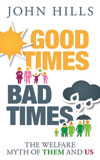David Kingman reviews an insightful book about how the welfare state operates in the UK
Professor Sir John Hills of the London School of Economics is arguably the UK’s leading academic expert on issues of poverty and social inequality. In his latest book, he brings his familiar clarity of expression and mastery of statistical evidence to bear on the controversial issue of who benefits from the welfare state and who pays for it, reaching some conclusions which may come as a surprise to most readers.
“Them and us”
The key myth which Sir John seeks to debunk is that Britain’s welfare state mainly performs what he calls a “Robin Hood” role by redistributing wealth from wealthier to poorer households. The popular misconception that this is its main role is often evoked by the media and politicians when they portray Britain’s population as being divided into two groups – the hard-working “strivers” who fund the system through their taxes and the so-called “scroungers” who live on benefits rather than getting a job (a vivid example of this rhetoric comes from a Conservative Party advertising campaign which the party launched in 2012).
Even among people who aren’t seeking to use such arguments to undermine support for the welfare state, there is a widely-held belief that a permanent underclass exists in Britain of people who are long-term unemployed, frozen out of the labour market and permanently dependent upon benefits to make ends meet.
In fact, as the evidence presented by Sir John in his book shows, most assumptions that people hold about the welfare state are wrong. While a “snapshot” view which looks only at the financial transfers taking place at any given moment shows a high level of redistribution between wealthier and poorer households, the former actually take almost as much out of the system as the latter do over their whole lifetimes.
Sir John presents evidence which shows that – even though poorer households make greater demands on the system through the types of income support which most people instinctively think of when they imagine “welfare”, such as tax credits and unemployment benefits – wealthier households place higher demands than poorer ones on the broader welfare state in other ways: they tend to stay longer at school and benefit more from public spending on higher education; they benefit far more from tax subsidies on building up savings; and they tend to live longer, so they receive more in state pensions and place greater demands on the NHS.
Overall, the vast majority of us rely on the welfare state at some point in our lives, and he estimates that most people get back as much as they put in. Contrary to common misconceptions, the main outcome of the British welfare state is lifetime redistribution (transferring money between different periods in someone’s life) rather than social redistribution.
The idea that there is a permanent class of welfare recipients is also undermined by some fascinating data which shows how volatile peoples’ incomes are over time. The average claim for unemployment benefit lasts just a few months, while many poorer households find that their income swings enormously from month to month, leaving them eligible for state-provided top-ups at some points but not at others. The book makes it very clear that the overall picture of who benefits from the welfare state at different times, and how much, is constantly in flux, which complicates efforts to design and administer benefits efficiently.
What about intergenerational justice?
The final section of the book addresses the issue of Britain’s ageing demography head-on, arguing that population forecasts suggest we will need to dramatically boost spending on our welfare state over the decades ahead in order to provide the same level of service, which implies higher taxes. Failing that, we would have to opt for a less generous welfare state.
The book also takes a brief look at intergenerational justice: a section which highlights how well a section of the current older generation has done from rising house prices, and how unlikely it is that most members of today’s younger generation will be able to amass sufficient lifetime wealth to match them, except through inheritance – a trend which will make Britain’s already high social inequalities even more unequal (although Sir John is at pains to point out that these are far from uniform trends: many baby-boomers are poor, and many members of today’s younger generation will still go on to do very well).
Overall, this book makes a timely, thoughtful and extremely well-argued contribution to the crucial debate about the future direction of the welfare state. It deserves to be required reading for anyone who wants to really understand the true picture of inequality and redistribution in Britain today.
“Good Times, Bad Times: The Welfare Myth of Them and Us” by Professor Sir John Hills is published by Policy Press (336 pages, ISBN: 9781447320036)
